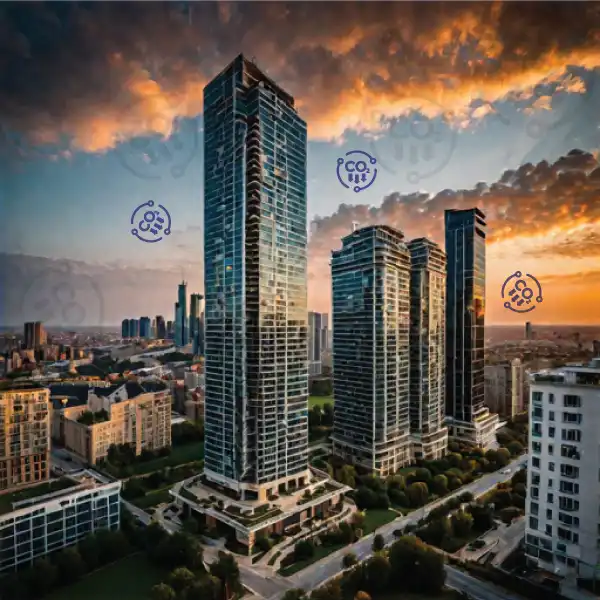In the holistic approach towards health and wellness, an often overlooked aspect is the quality of the air we breathe, specifically the concentration of carbon dioxide (CO2) in our indoor environments. CO2, a natural part of our atmosphere, plays a critical role in life’s cycle on Earth.
However, when its concentration in an enclosed space like a building reaches excessive levels, it can compromise health, causing a range of issues. Therefore, understanding and maintaining acceptable CO2 levels in buildings is imperative to ensuring a conducive and healthful indoor environment.
At Oizom, our purpose-driven mission is to promote healthier indoor air quality by offering advanced and robust monitors.
What is CO2?
Carbon dioxide, or CO2, is a colourless, odourless gas that naturally exists in our atmosphere. It is a crucial component of the Earth’s life cycle as plants absorb CO2 for photosynthesis, which is later released into the atmosphere through respiration and decay.
However, human activities, particularly burning fossil fuels and deforestation, have increased CO2 concentrations, with far-reaching implications for the outdoor environment and indoor air quality in our homes, schools, and workplaces.
The Effects of High CO2 Levels on Buildings
In indoor environments, particularly in buildings with poor ventilation, CO2 levels can quickly build up. When individuals are exposed to high CO2 concentrations, they may experience a host of health symptoms.
Initial signs include mild headaches, dizziness, shortness of breath, and a noticeable decrease in cognitive function, such as concentration and decision-making abilities.
As CO2 levels rise further, these symptoms can intensify, potentially leading to severe headaches, disorientation, visual and hearing disturbances, unconsciousness, and in extreme cases, even death.
Therefore, monitoring and controlling CO2 levels in buildings is not just crucial for maintaining occupant comfort, but it is also a matter of public health and safety.
Determining Acceptable CO2 Levels
Understanding acceptable CO2 levels in indoor environments can help create a safe and comfortable space for occupants. The UK Health and Safety Executive suggests that CO2 levels up to 1,000 ppm (parts per million) are generally acceptable for most indoor environments. This level ensures minimal adverse impact on health and overall comfort.
However, if CO2 levels rise to 5,000 ppm or above, it signals inadequate ventilation and can lead to more severe health effects. Thus, knowing these thresholds is essential for facility managers and building owners to ensure the well-being of the building’s occupants.
Measuring CO2 Levels
Monitoring CO2 levels can offer insights into the indoor air quality of a building. With devices like Oizom’s Air Quality Monitors, facility managers can get real-time readings of CO2 concentrations, helping them stay informed and respond effectively when levels approach or exceed acceptable thresholds.
By leveraging data from these devices, they can identify problem areas, devise remediation strategies, and create a more healthful indoor environment.
The Impact of Ventilation
Ventilation plays a pivotal role in maintaining acceptable CO2 levels. A well-functioning ventilation system ensures an efficient exchange of indoor air with outdoor air, helping to expel excessive CO2 and other indoor pollutants.
However, ventilation alone isn’t a comprehensive solution. It needs to be complemented with other strategies, such as proper building design and occupant education, for effective CO2 management.
Health Benefits of Maintaining Acceptable CO2 Levels
The benefits of maintaining acceptable CO2 levels extend far beyond merely meeting regulatory requirements. A healthier indoor environment can reduce the risk of headaches, lethargy, and impaired cognitive function associated with high CO2 levels.
It can also enhance productivity in office settings, contribute to better learning outcomes in schools, and promote overall wellness in homes.
Challenges in Controlling CO2 Levels
Despite the criticality of controlling CO2 levels, it often presents a challenge, particularly in densely occupied spaces like offices and classrooms. Factors such as building design, occupancy levels, the nature of activities within the building, and the effectiveness of ventilation systems all contribute to indoor CO2 concentrations.
Therefore, a combination of regular monitoring, occupant education, and timely intervention is crucial in managing CO2 levels effectively. Below are some of the major challenges:
Technological Challenges:
Controlling CO2 levels in buildings presents several technological challenges. First, achieving precise monitoring of CO2 levels requires advanced sensors and control systems, often demanding significant investments.
Inadequate maintenance or calibration of these systems can lead to inaccuracies. Second, designing and implementing HVAC systems that adjust air circulation and filtration based on real-time CO2 data is complex.
Moreover, this integration with existing systems is not always straightforward. Another challenge is reducing industrial CO2 emissions without compromising energy efficiency, as some mitigation strategies can result in increased energy use.
Finally, the adoption of smart technologies is hindered by issues of interoperability, user acceptance, and privacy concerns.
Economic Impediments:
Economic challenges are also a key obstacle in the path to CO2 reduction. The transition to a low-carbon economy requires significant capital investment and potentially increased operational costs.
Additionally, fossil fuels, a significant source of CO2 emissions, often remain cheaper and more readily accessible than cleaner alternatives. This disparity creates a disincentive for industries and individuals to reduce their reliance on high-carbon energy sources.
Establishing a more favorable economic environment that encourages investment in cleaner technologies and practices is a significant challenge.
Policy and Regulatory Hurdles:
Policy and regulatory hurdles present another significant challenge. Effective control of CO2 levels requires comprehensive, coherent, and enforceable policies that regulate emissions and encourage the adoption of sustainable practices.
However, practices like Carbon Credits are mandatory in industrieswhich can be difficult to follow for several industries.
Due to political, economic, and social factors, it can be challenging to develop and implement such policies on a global scale. Countries might have different priorities and capacities to enforce such policies, leading to disparities in efforts and effectiveness in controlling CO2 levels.
Public Awareness and Behaviour Change:
Public awareness and behaviour change also pose challenges to controlling CO2 levels. Many people remain unaware of the impact of their actions on CO2 emissions, and even those who are aware might be unwilling or unable to change their behaviours due to a variety of factors, such as financial constraints or ingrained habits.
Thus, enhancing public understanding of climate change and promoting sustainable behaviours is a complex and ongoing challenge.
Global Coordination:
Lastly, the global nature of climate change necessitates international coordination and cooperation to control CO2 levels effectively. This coordination, however, is easier said than done due to differing national interests, unequal capacities, and complexities of international politics.
Ensuring that all nations, particularly those most responsible for CO2 emissions, actively participate in and adhere to global emission reduction efforts remains a significant challenge.
Conclusion
Monitoring and maintaining appropriate CO2 levels is critical to creating and managing healthy indoor environments. Leveraging technology, like Oizom’s Air Quality Monitors, we can better understand and control the air we breathe within our homes, schools, and workplaces. By prioritising indoor air quality, we can foster healthier and more productive indoor environments for all.
Frequently Asked Questions (FAQs)
The UK Health and Safety Executive recommends CO2 levels not exceeding 1,000 ppm for a typical indoor environment.
CO2 levels should ideally be kept under 1,000 ppm for a residential setting to ensure a healthy and comfortable environment.
To maintain a healthy indoor environment, the concentration of CO2 should ideally be kept below 1,000 ppm.
High CO2 levels can deteriorate indoor air quality, leading to a range of health issues such as headaches, dizziness, and impaired cognitive function.
Commercial buildings should ideally maintain CO2 concentrations below 1,000 ppm. CO2 levels above 5,000 ppm could pose significant health risks and indicate poor ventilation.
Take control of your indoor air quality today with Oizom's Air Quality Monitors. Discover how our devices can help create a safer, healthier, and more productive indoor environment. Contact us today for more information.






